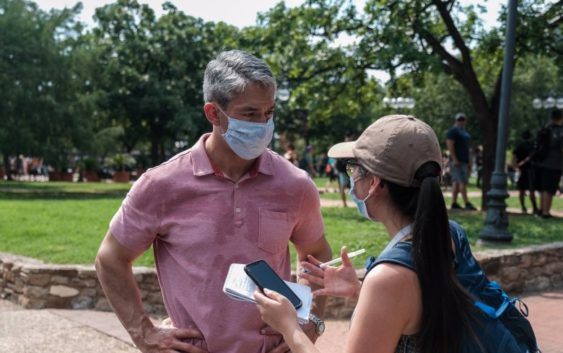- Here's how to get your flooding debris picked up by the City of Houston
- Mosquito activity on the rise due to rainfall, flooding across Texas
- Volunteers help Conroe community clean up in wake of flooding in Montgomery County
- Why leaders are urging NC residents to start hurricane prep now
- Storms could produce hail, damaging winds south of Charlotte
Freeman Coliseum overflow hospital used for first time – for hurricane evacuees

An overflow hospital facility at Freeman Coliseum that has been set up since spring welcomed its first occupants this week as people escaping Hurricane Laura arrived in San Antonio.
As of Wednesday evening, 2,100 hurricane evacuees had been processed in San Antonio, Mayor Ron Nirenberg said. Some are staying at Freeman Coliseum, which had been set up as an overflow space if the number of local coronavirus patients exceeded bed space in area hospitals. There are no COVID patients in Freeman Coliseum, but if there were to be, they would be separated from everyone else, Bexar County Judge Nelson Wolff said.
“The ones that are in there are not necessarily coming from a hospital,” Wolff said. “They were not hospital patients, but they were patients in nursing homes, assisted living [facilities] that require additional assistance. So they have a whole team of medical technicians and everybody out there to help them.”
For some of those staying at Freeman Coliseum, family members are being housed in a separate area of the facility, Wolff said.
Nirenberg had said Tuesday that the City anticipated only about 50 evacuees.
“As of 12 o’clock last night it still looked like there wasn’t going to be a lot of people, as the mayor stated yesterday,” Wolff said. “There were only a few cars out there, it seemed like. But now, we’ve got a line of cars that stretch out a probably good half-a-mile or longer. So they came and came fast, and I must say we didn’t get a lot of warning about that, so we had to respond very quickly to it.”
Jennifer Herriott, deputy director of San Antonio Metropolitan Health, said Metro Health has set up two medical stations for evacuees at a Marriott hotel and La Quinta Inn in town. She declined to specify which ones or share which hotels were housing evacuees in San Antonio.
“Our goal is to maintain just the two medical stations at the larger places and transport people there if they need any kind of visit with a medical provider,” Herriott said.
As San Antonians are still trying to prevent coronavirus spread, Herriott said she was “pleased” to see the majority of the people downtown on Wednesday wearing masks.
“We are providing them with information about what our local regulations are … so I think they are being reminded to maintain social distance, to wear their masks, and to isolate,” she said.
Nirenberg said he’s not sure what the City’s limit for hosting evacuees would be, but making hotel rooms available for shelter is really a question of staffing those hotels.
“Our advantage is that we wrote the book on emergency response here in San Antonio and that’s all based here, we deploy from here,” Nirenberg said. “We do have thousands of hotel rooms potentially available if we can get staffed up and turn the lights on, and they’re doing that as quickly as possible. But I wouldn’t be in any other city if I was an evacuee.”
Meanwhile, Bexar County’s hospital numbers continue to trend downward, with 22 fewer patients in area hospitals Wednesday for COVID-19. Of the 436 hospitalized, 202 were in intensive care and 134 on ventilators.
Metro Health reported 134 new cases of coronavirus on Wednesday, bringing the total to 45,622. Officials also reported 13 more deaths that occurred between June 21 and Aug. 25; 754 people have died of the novel coronavirus since the pandemic started.
Every day brings new developments and decisions by government and public health leaders to control the local coronavirus outbreak. We strive to be a trustworthy news source for all in the community–especially during this tumultuous time.
You rely on us for credible reporting, and we rely on readers like you to support our nonprofit newsroom. Can we count on you?

Our reporters are risking a lot to be on the streets chronicling this unprecedented crisis and its impact on our health care systems, local economy, and daily lives. We’ve been asking our readers to show support for this important public service by making a monthly donation or a one-time gift in whatever amount you can afford.
These donations are helping offset the loss of advertising revenue we normally rely on from local businesses. Can we count on you?
Four of the deaths reported Wednesday were determined to be coronavirus-related by Metro Health after reviewing death certificates, Nirenberg said. Nine men and four women between ages 40 and 99 died and all had underlying medical conditions. One of the 13 died in hospice care, while three had been admitted to PAM Specialty Hospital of San Antonio, four at Christus Santa Rosa Westover Hills, two at Southwest General, and one each at Methodist Stone Oak, Northeast Methodist, and North Central Baptist.
Ages and ethnicities of deceased
● 5 Hispanic men between ages 40 and 99
● 3 Hispanic women between ages 50 and 79
● 2 white men between ages 70 and 99
● 2 men of unknown ethnicity between ages 60 and 79
● 1 white woman in her 60s